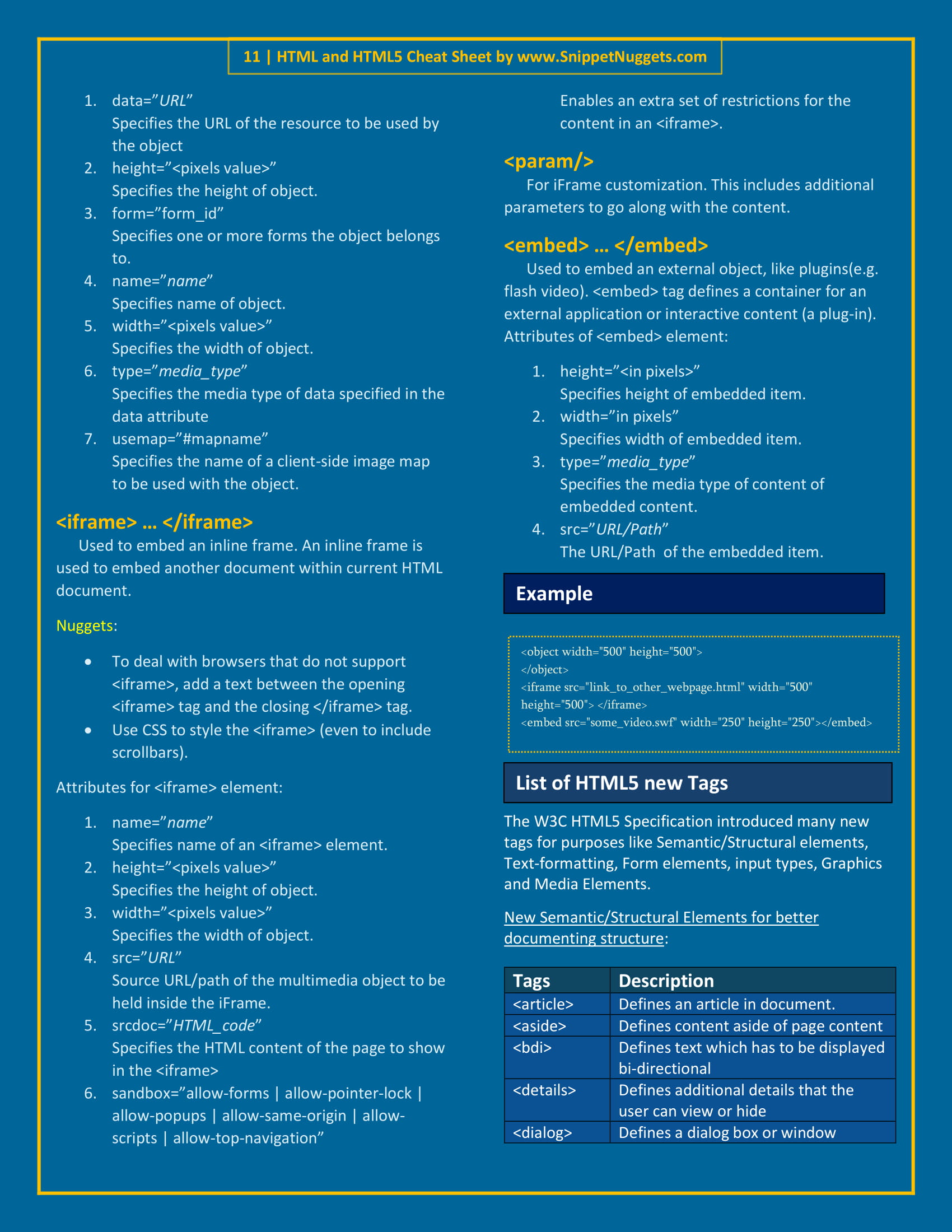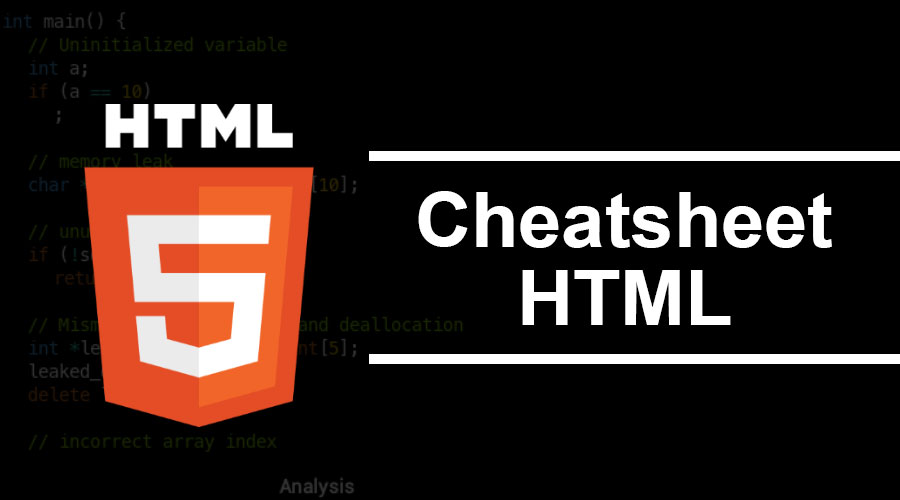Semantic elements = elements with a meaning.
What are Semantic Elements?
- This cheat sheet not only contains list of all HTML and HTML5 tags but also best practices, important points and related information about each tags. You can bookmark this page for future reference or take a printout of the given document to master HTML in a better and easy way.
- The Ultimate HTML Cheat Sheet: A List of HTML Tags. Reading time 7 min. Published Mar 21, 2019. Updated Sep 30, 2019. HTML5 semantic tags and HTML5 semantic.
HTML Cheat Sheet by Marco Santos (marconlsantos) via cheatography.com/39521/cs/12307/ Tables Main table tag, encaps ulates all the others. Semantic HTML is the use of named HTML markup to mark the semantics, or meaning of content on a webpage or a web application. There are a lot of HTML5 semantic elements note / cheat sheet that you can find online. For (let key, value of Object.entries(object1)) returns array of object's keys and values: key, value MDN.
A semantic element clearly describes its meaning to both the browser and the developer.
Examples of non-semantic elements: <div> and <span> - Tells nothing about its content.
Examples of semantic elements: <form>, <table>, and <article> - Clearly defines its content.
Semantic Elements in HTML
Many web sites contain HTML code like: <div> <div> <div> to indicate navigation, header, and footer.
In HTML there are some semantic elements that can be used to define different parts of a web page:
- <article>
- <aside>
- <details>
- <figcaption>
- <figure>
- <footer>
- <header>
- <main>
- <mark>
- <nav>
- <section>
- <summary>
- <time>
HTML <section> Element
The <section> element defines a section in a document.
According to W3C's HTML documentation: 'A section is a thematic grouping of content, typically with a heading.'
A web page could normally be split into sections for introduction, content, and contact information.
Example

Two sections in a document:
<h1>WWF</h1>
<p>The World Wide Fund for Nature (WWF) is an international organization working on issues regarding the conservation, research and restoration of the environment, formerly named the World Wildlife Fund. WWF was founded in 1961.</p>
</section>
<section>
<h1>WWF's Panda symbol</h1>
<p>The Panda has become the symbol of WWF. The well-known panda logo of WWF originated from a panda named Chi Chi that was transferred from the Beijing Zoo to the London Zoo in the same year of the establishment of WWF.</p>
</section>
HTML <article> Element
The <article> element specifies independent, self-contained content.
An article should make sense on its own, and it should be possible to distribute it independently from the rest of the web site.


Examples of where an <article> element can be used:
- Forum post
- Blog post
- Newspaper article
Example
Three articles with independent, self-contained content:
<h2>Google Chrome</h2>
<p>Google Chrome is a web browser developed by Google, released in 2008. Chrome is the world's most popular web browser today!</p>
</article>
<article>
<h2>Mozilla Firefox</h2>
<p>Mozilla Firefox is an open-source web browser developed by Mozilla. Firefox has been the second most popular web browser since January, 2018.</p>
</article>
<article>
<h2>Microsoft Edge</h2>
<p>Microsoft Edge is a web browser developed by Microsoft, released in 2015. Microsoft Edge replaced Internet Explorer.</p>
</article>
Example 2
Use CSS to style the <article> element:
<head>
<style>
.all-browsers {
margin: 0;
padding: 5px;
background-color: lightgray;
}
.all-browsers > h1, .browser {
margin: 10px;
padding: 5px;
}
.browser {
background: white;
}
.browser > h2, p {
margin: 4px;
font-size: 90%;
}
</style>
</head>
<body>
<article>
<h1>Most Popular Browsers</h1>
<article>
<h2>Google Chrome</h2>
<p>Google Chrome is a web browser developed by Google, released in 2008. Chrome is the world's most popular web browser today!</p>
</article>
<article>
<h2>Mozilla Firefox</h2>
<p>Mozilla Firefox is an open-source web browser developed by Mozilla. Firefox has been the second most popular web browser since January, 2018.</p>
</article>
<article>
<h2>Microsoft Edge</h2>
<p>Microsoft Edge is a web browser developed by Microsoft, released in 2015. Microsoft Edge replaced Internet Explorer.</p>
</article>
</article>
</body>
</html>
Nesting <article> in <section> or Vice Versa?
The <article> element specifies independent, self-contained content.
The <section> element defines section in a document.
Can we use the definitions to decide how to nest those elements? No, we cannot!
So, you will find HTML pages with <section> elements containing <article> elements, and <article> elements containing <section> elements.
HTML <header> Element
The <header> element represents a container for introductory content or a set of navigational links.
A <header> element typically contains:
- one or more heading elements (<h1> - <h6>)
- logo or icon
- authorship information
Note: You can have several <header> elements in one HTML document. However, <header> cannot be placed within a <footer>, <address> or another <header> element.
Example
A header for an <article>:
<header>
<h1>What Does WWF Do?</h1>
<p>WWF's mission:</p>
</header>
<p>WWF's mission is to stop the degradation of our planet's natural environment,
and build a future in which humans live in harmony with nature.</p>
</article>
HTML <footer> Element
The <footer> element defines a footer for a document or section.
A <footer> element typically contains:
- authorship information
- copyright information
- contact information
- sitemap
- back to top links
- related documents
You can have several <footer> elements in one document.
Example
A footer section in a document:
<p>Author: Hege Refsnes</p>
<p><a href='mailto:hege@example.com'>hege@example.com</a></p>
</footer>
HTML <nav> Element
The <nav> element defines a set of navigation links.
Notice that NOT all links of a document should be inside a <nav> element. The <nav> element is intended only for major block of navigation links.
Browsers, such as screen readers for disabled users, can use this element to determine whether to omit the initial rendering of this content.
Example
A set of navigation links:
<a href='/html/'>HTML</a> |
<a href='/css/'>CSS</a> |
<a href='/js/'>JavaScript</a> |
<a href='/jquery/'>jQuery</a>
</nav>

HTML <aside> Element
The <aside> element defines some content aside from the content it is placed in (like a sidebar).
The <aside> content should be indirectly related to the surrounding content.
Example
Display some content aside from the content it is placed in:
<aside>
<h4>Epcot Center</h4>
<p>Epcot is a theme park at Walt Disney World Resort featuring exciting attractions, international pavilions, award-winning fireworks and seasonal special events.</p>
</aside>
Example 2
Jagged alliance 2 classic. Use CSS to style the <aside> element:
<head>
<style>
aside {
width: 30%;
padding-left: 15px;
margin-left: 15px;
float: right;
font-style: italic;
background-color: lightgray;
}
</style>
</head>
<body>
<p>My family and I visited The Epcot center this summer. The weather was nice, and Epcot was amazing! I had a great summer together with my family!</p>
<aside>
<p>The Epcot center is a theme park at Walt Disney World Resort featuring exciting attractions, international pavilions, award-winning fireworks and seasonal special events.</p>
</aside>
<p>My family and I visited The Epcot center this summer. The weather was nice, and Epcot was amazing! I had a great summer together with my family!</p>
<p>My family and I visited The Epcot center this summer. The weather was nice, and Epcot was amazing! I had a great summer together with my family!</p>
</body>
</html>
HTML <figure> and <figcaption> Elements
The <figure> tag specifies self-contained content, like illustrations, diagrams, photos, code listings, etc.
The <figcaption> tag defines a caption for a <figure> element. The <figcaption> element can be placed as the first or as the last child of a <figure> element.
The <img> element defines the actual image/illustration.
Example
<img src='pic_trulli.jpg' alt='Trulli'>
<figcaption>Fig1. - Trulli, Puglia, Italy.</figcaption>
</figure>
Why Semantic Elements?
According to the W3C: 'A semantic Web allows data to be shared and reused across applications, enterprises, and communities.'
Semantic Elements in HTML
Below is a list of some of the semantic elements in HTML.
| Tag | Description |
|---|---|
| <article> | Defines independent, self-contained content |
| <aside> | Defines content aside from the page content |
| <details> | Defines additional details that the user can view or hide |
| <figcaption> | Defines a caption for a <figure> element |
| <figure> | Specifies self-contained content, like illustrations, diagrams, photos, code listings, etc. |
| <footer> | Defines a footer for a document or section |
| <header> | Specifies a header for a document or section |
| <main> | Specifies the main content of a document |
| <mark> | Defines marked/highlighted text |
| <nav> | Defines navigation links |
| <section> | Defines a section in a document |
| <summary> | Defines a visible heading for a <details> element |
| <time> | Defines a date/time |
For a complete list of all available HTML tags, visit our HTML Tag Reference.
XHTML 2 is dead, long live HTML5! According to W3C News Archive, XHTML 2 working group is expected to stop work end of 2009 and W3C is planning to increase resources on HTML5 instead. And even although HTML 5 won’t be completely supported until 2022, it doesn’t mean that it won’t be widely adopted within the foreseeable future.
So in the spirit of the upcoming change we decided to release a handy printable HTML5 Cheat Sheet that lists all currently supported tags, their descriptions, their attributes and their support in HTML4.
Further Reading on SmashingMag:
Please notice that the specification is an ongoing work, and is expected to remain so for many years, although parts of HTML5 are going to be finished and implemented in browsers before the whole specification reaches final Recommendation status. We’ll do our best to update the cheat sheet when new changes will become known. The cheat sheet was created by our friends from Veign and released exclusively for the readers of Smashing Magazine.
Download the cheat sheet for free!
- preview (.gif, 1017×836px)
- download the pdf (76 Kb)
Thank you very much, Chris Hanscom! We appreciate your efforts.
Further Resources About HTML 5
- HTML5 Demos A couple of HTML 5 examples and experiments.
- HTML5 Doctor This blog publishes articles relating to HTML5 and it’s semantics and how to use them, here and now.
- HTML5 Gallery A showcase of sites using html5 markup.
Html Tags Cheat Sheet
Do you already use HTML5 in your projects? Would you recommend using HTML5? Let us know in the comments!
